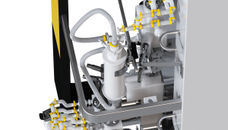Researchers show how cells open 'doors' to release neurotransmitters
Like opening a door to exit a room, cells in the body open up their outer membranes to release such chemicals as neurotransmitters and other hormones.
Cornell researchers have shed new light on this lightning-quick, impossibly small-scale process, called exocytosis, by casting sharp focus on what happens right at the moment the "doors" on the cell wall open.
Publishing online Oct. 11 in Proceedings of the National Academy of Sciences, researchers led by Cornell's Manfred Lindau used a combination of molecular biology, electrophysiology, microfabricated electrochemical sensors and advanced microscopy to elucidate exocytosis of noradrenaline. This is a neurotransmitter released from the adrenal gland by a type of neuroendocrine cell called a chromaffin cell.
Lindau, professor of applied and engineering physics, studies the properties of exocytosis by looking at how packets of chemicals called vesicles adhere to the cell wall and open the door between the vesicle interior and cell's exterior. This "door" is called the fusion pore.
"Biochemists have been working on experiments to identify what proteins and molecules are the main players in this mechanism of release," Lindau said.
It turns out that neurotransmitter release is largely regulated by a set of proteins called SNARE proteins, and one called synaptobrevin is located on the cell's vesicle membrane. The synaptobrevins bind with other proteins called syntaxin and SNAP-25, which are located in the plasma membrane that encloses the cell. When the cell is excited and the neurotransmitter release is triggered, these proteins together are believed to open the fusion pore.
Lindau's team of researchers used genetically altered mouse embryos that lacked synaptobrevin and introduced viruses with modified versions of the protein into their experiments. They then imaged and studied the release function of the cells for the different versions of the synaptobrevins.
They discovered that one end of the synaptobrevin -- the part that anchors it in the vesicle membrane -- is pulled deeper into the vesicle membrane when the cell is stimulated. This movement is what temporarily changes the structure of the membrane and allows the opening of the fusion pore and neurotransmitter release. It had previously been thought that the fusion pore originates by an indirect effect of the SNARE protein in the membrane lipids. Lindau's experiments have shown that the vesicle membrane component of synaptobrevin is the active part of the molecular nanomachine that forms the fusion pore.
To continue visualizing the molecular details of this complex process, Lindau is working on sabbatical at the University of Oxford with professor Mark Sansom on molecular dynamics and computer simulations of the SNARE proteins and neurotransmitter exocytosis.
The research published in PNAS was funded primarily by the National Institutes of Health and the Cornell Nanobiotechnology Center, which is supported by the National Science Foundation. The paper's authors include former Cornell graduate students Annita Ngatchou and Kassandra Kisler, postdoctoral associates Qinghua Fang and Yong Zhao, and collaborators from the Max Planck Institute for Biophysical Chemistry, the University of Saarland in Germany and the University of Copenhagen.
Most read news
Topics
Organizations
Other news from the department science
These products might interest you

Hahnemühle LifeScience Catalogue Industry & Laboratory by Hahnemühle
Wide variety of Filter Papers for all Laboratory and Industrial Applications
Filtration Solutions in the Life Sciences, Chemical and Pharmaceutical Sectors

Hydrosart® Ultrafilter by Sartorius
Efficient ultrafiltration for biotech and pharma
Maximum flow rates and minimum protein loss with Hydrosart® membranes

Hydrosart® Microfilter by Sartorius
Hydrophilic microfilters for bioprocesses
Minimal protein adsorption and high flow rates

Sartopore® Platinum by Sartorius
Efficient filtration with minimal protein adsorption
Reduces rinsing volume by 95 % and offers 1 m² filtration area per 10"

Polyethersulfone Ultrafilter by Sartorius
Reliable filtration with PESU membranes
Perfect for biotechnology and pharmaceuticals, withstands sterilisation and high temperatures

Polyethersulfone Microfilter by Sartorius
Biotechnological filtration made easy
Highly stable 0.1 µm PESU membranes for maximum efficiency

Sartobind® Rapid A by Sartorius
Efficient chromatography with disposable membranes
Increase productivity and reduce costs with fast cycle times

Get the life science industry in your inbox
By submitting this form you agree that LUMITOS AG will send you the newsletter(s) selected above by email. Your data will not be passed on to third parties. Your data will be stored and processed in accordance with our data protection regulations. LUMITOS may contact you by email for the purpose of advertising or market and opinion surveys. You can revoke your consent at any time without giving reasons to LUMITOS AG, Ernst-Augustin-Str. 2, 12489 Berlin, Germany or by e-mail at revoke@lumitos.com with effect for the future. In addition, each email contains a link to unsubscribe from the corresponding newsletter.



















































